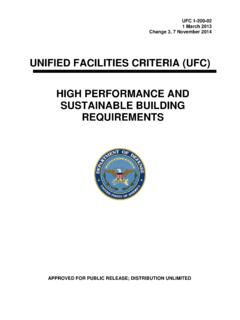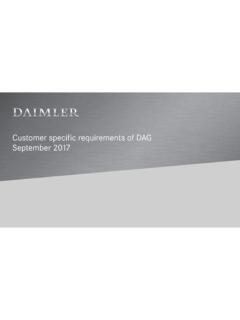Transcription of September 19, 2017 - Under Secretary of Defense for ...
1 September 19, 2017 . Guidance for Selected Elements of DFARS Clause , Safeguarding Covered Defense Information and Cyber Incident Reporting . Implementing the Security Requirements of NIST SP 800-171. DFARS Clause , Safeguarding Covered Defense Information and Cyber Incident Reporting, requires contractors to provide adequate security for covered Defense information that is processed, stored, or transmitted on the contractor's internal information system or network. The Department must mark, or otherwise identify in the contract, any covered Defense information that is provided to the contractor, and must ensure that the contract includes the requirement for the contractor to mark covered Defense information developed in performance of the contract. To provide adequate security, the contractor must, at a minimum, implement National Institute of Standards and Technology (NIST) Special Publication (SP) 800- 171, Protecting Controlled Unclassified Information in Nonfederal Information Systems and Organizations, not later than December 31, 2017 .
2 This guidance is provided for DoD acquisition personnel in anticipation of the December 31, 2017 , deadline. It outlines, in general, the manner in which contractors are likely to approach implementing NIST SP 800-171; addresses how a contractor may use a system security plan to document implementation of the NIST SP 800-171 security requirements; and describes examples of how DoD organizations might choose to leverage the contractor's system security plan, and any associated plans of action, in the contract formation, administration, and source selection processes. Contractor Implementation of NIST SP 800-171, Protecting Controlled Unclassified Information (CUI) in Nonfederal Information Systems and Organizations NIST SP 800-171 was developed for use on contractor and other nonfederal information systems and networks to protect Controlled Unclassified Information (CUI).
3 DFARS Clause requires that contractors implement NIST SP 800-171 to protect systems and networks that process, store, or transmit covered Defense information (as defined in the clause). NIST SP 800-171 provides a single, Government-wide set of performance-based security requirements that significantly reduce unnecessary specificity ( , as compared to prescribing detailed security controls), which enables contractors to comply in most cases by using or adapting systems and practices already in place. There is no single or prescribed manner in which a contractor may choose to implement the requirements of NIST SP 800-171, or to assess their own compliance with those requirements. For companies new to the requirements, a reasonable first step may be for company personnel with knowledge of their information systems security practices to read through the publication, examining each requirement to determine if it may require a change to company policy or processes, a configuration change for existing company information technology (IT), or if it requires an additional software or hardware solution.
4 Most requirements 1. in NIST SP 800-171 are about policy, process, and configuring IT securely. These requirements entail determining what the company policy should be ( , what should be the interval between required password changes) and then configuring the IT system to implement the policy. Some requirements will require security-related software (such as anti-virus) or additional hardware ( , firewall). The complexity of the company IT system may determine whether additional software or tools are required. For smaller systems, the company may accomplish many requirements manually, such as configuration management or patch management, while larger and more complex systems may require automated software tools to perform the same task. Having reviewed all of the security requirements, a company may then determine which of the requirements, 1) can be accomplished by their own in-house IT personnel, 2) require additional research in order to be accomplished by company personnel, and 3) require outside assistance.
5 If unsure of what a requirement means, companies may seek additional guidance in the mapping table in Appendix D of NIST SP 800-171, which maps each of the NIST SP 800-171. requirements to relevant security controls that are specified in NIST SP 800-53, Security and Privacy Controls for Federal Information Systems and Organizations. After identifying the corresponding NIST SP 800-53 control, the company may consult the Supplemental Guidance . section of the description of that control in NIST SP 800-53 to find clarifying guidance and examples of how to implement that control, which the company may choose to utilize for its implementation of the more performance-based 800-171 requirements. When doing this, companies should be aware that not all aspects of a NIST SP 800-53 security control may have been included in NIST SP 800-171 security requirement, and as such, not all of the Supplemental Guidance may apply.
6 Ultimately, it is the contractor's responsibility to determine whether it is has implemented the NIST SP 800-171 (as well as any other security measures necessary to provide adequate security for covered Defense information). Third party assessments or certifications of compliance are not required, authorized, or recognized by DoD, nor will DoD certify that a contractor is compliant with the NIST SP 800-171 security requirements. Documenting a Contractor's Implementation or Planned Implementation of NIST 800-171. NIST SP 800-171 was revised (Revision 1) in December 2016 to enable nonfederal organizations to demonstrate implementation or planned implementation of the security requirements with a system security plan and associated plans of action.. Security requirement (System Security Plan, added by NIST SP 800-171, Revision 1), requires the contractor to develop, document, and periodically update, system security plans that describe system boundaries, system environments of operation, how security requirements are implemented, and the relationships with or connections to other systems.
7 2. Security Requirement (Plans of Action), requires the contractor to develop and implement plans of action designed to correct deficiencies and reduce or eliminate vulnerabilities in their systems. Note that DFARS Clause requires the contractor to implement the version of the NIST SP 800-171 that is in effect at the time of the solicitation, or such other version that is authorized by the contracting officer. Thus, if Revision 1 of NIST SP 800-171 was not in effect at the time of the solicitation, the contractor should work with the contracting officer to modify the contract to authorize the use of NIST SP 800-171, Revision 1, dated December 2016. DoD guidance is for contracting officers to work with contractors who request assistance in the consistent implementation of the latest version of DFARS Clause and NIST SP. 800-171, Revision 1. To document implementation of the NIST SP 800-171 security requirements by the December 31, 2017 , implementation deadline, companies should have a system security plan in place, in addition to any associated plans of action to describe how and when any unimplemented security requirements will be met, how any planned mitigations will be implemented, and how and when they will correct deficiencies and reduce or eliminate vulnerabilities in the systems.
8 Organizations can document the system security plan and plans of action as separate or combined documents in any chosen format. There are a number of mechanisms by which the contractor can inform the Government of the contractor's implementation of the NIST SP 800-171 requirements. The solicitation provision DFARS , Compliance with Safeguarding Covered Defense Information Controls, provides that by submitting the offer the contractor is representing its compliance (and provides a procedure for the contractor to request the DoD Chief Information Officer (CIO) to authorize a variance from any of those requirements as being non-applicable, or because the contractor has a different but equally effective security measure). In addition, paragraph (c)(2)(ii)(A) of DFARS Clause requires the contractor that is performing a contract awarded prior to October 1, 2017 , to notify the DoD CIO of any requirements of NIST.
9 SP 800-171 that are not implemented at the time of contract award. In addition, the solicitation may require or allow elements of the system security plan, which demonstrates/documents implementation of NIST SP 800-171, to be included with the contractor's technical proposal, and may subsequently be incorporated (usually by reference) as part of the contract ( , via a Section H special contract requirement). Contractors have indicated in public forums that system security plans or plans of action will likely contain company sensitive information. Incorporating the plans by reference, and advising the companies to ensure their plans are marked with an appropriate restrictive notice or marking ( , to indicate that it contains proprietary or other sensitive information) should address those concerns. DFARS Clause does not add any other unique or additional requirements for the Government to monitor contractor implementation of NIST SP 800-171 or to monitor compliance with any other requirement of that clause.
10 As noted previously, third party 3. assessments or certifications of compliance are not required, authorized, or recognized by DoD, nor will DoD certify that a contractor is compliant with the NIST SP 800-171 security requirements. If the requiring activity/buying activity determines that oversight related to the security requirements is necessary, they may add requirements to the terms of the contract as addressed below. Role of the System Security Plan and Plans of Action in Contract Formulation, Administration, and Source Selection Chapter 3 of NIST SP 800-171, Revision 1, states that Federal agencies may consider the contractor's system security plan and plans of action as critical inputs to an overall risk management decision to process, store, or transmit CUI on a system hosted by a nonfederal organization, and whether or not it is advisable to pursue an agreement or contract with the nonfederal organization.














